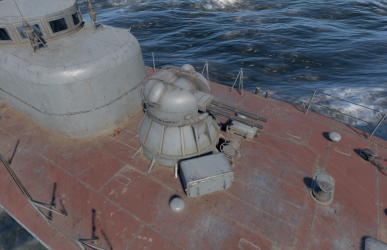Difference between revisions of "AK-230 (30 mm)"
(→History: Added History) (Tag: Visual edit) |
Colok76286 (talk | contribs) (Undo revision 162372 by U21817146 (talk) Plagiarism from http://www.navweaps.com/Weapons/WNRussian_30mm-63_ak-230.php) |
||
| (3 intermediate revisions by one other user not shown) | |||
| Line 1: | Line 1: | ||
| + | [[File:AK-230 on Project 206.png|thumb|x250px|30 mm AK-230 on the [[Pr. 206]]]] | ||
| + | |||
== Description == | == Description == | ||
<!--''Write an introduction to the article in 2-3 small paragraphs. Briefly tell us about the history of the development and combat using the weaponry and also about its features. Compile a list of air, ground, or naval vehicles that feature this weapon system in the game.''--> | <!--''Write an introduction to the article in 2-3 small paragraphs. Briefly tell us about the history of the development and combat using the weaponry and also about its features. Compile a list of air, ground, or naval vehicles that feature this weapon system in the game.''--> | ||
| Line 34: | Line 36: | ||
== History == | == History == | ||
| − | + | ''Examine the history of the creation and combat usage of the weapon in more detail than in the introduction. If the historical reference turns out to be too long, take it to a separate article, taking a link to the article about the weapon and adding a block "/ History" (example: <nowiki>https://wiki.warthunder.com/(Weapon-name)/History</nowiki>) and add a link to it here using the <code>main</code> template. Be sure to reference text and sources by using <code><nowiki><ref></ref></nowiki></code>, as well as adding them at the end of the article with <code><nowiki><references /></nowiki></code>.'' | |
| − | |||
| − | |||
| − | |||
| − | |||
| − | |||
| − | |||
== Media == | == Media == | ||
Latest revision as of 07:24, 11 May 2023

Contents
Description
The 30 mm AK-230 is a Soviet twin-barrel autocannon used on naval vessels.
Vehicles equipped with this weapon
General info
Tell us about the tactical and technical characteristics of the cannon or machine gun.
Available ammunition
Describe the shells that are available for the weapon and their features and purpose. If it concerns autocannons or machine guns, write about different ammo belts and what is inside (which types of shells).
Comparison with analogues
Give a comparative description of cannons/machine guns that have firepower equal to this weapon.
Usage in battles
Describe the cannon/machine gun in the game - its distinctive features, tactics of usage against notable opponents. Please don't write a "guide" - do not impose a single point of view, but give the reader food for thought.
Pros and cons
Summarise and briefly evaluate the weaponry in terms of its characteristics and combat effectiveness. Mark pros and cons as a list.
Pros:
Cons:
History
Examine the history of the creation and combat usage of the weapon in more detail than in the introduction. If the historical reference turns out to be too long, take it to a separate article, taking a link to the article about the weapon and adding a block "/ History" (example: https://wiki.warthunder.com/(Weapon-name)/History) and add a link to it here using the main template. Be sure to reference text and sources by using <ref></ref>, as well as adding them at the end of the article with <references />.
Media
Excellent additions to the article would be video guides, screenshots from the game, and photos.
See also
- 30 mm/54 AK-630 (30 mm) - A Soviet autocannon that succeeded the AK-230
External links
| Germany naval cannons | |
|---|---|
| 15 mm | MG 151 |
| 20 mm | 2 cm/65 C/30 · 2 cm/65 C/38 · 2 cm/65 Flakzwilling 38 · 2 cm/65 Flakvierling 38 · MG 151/20 |
| 30 mm | MK103/38 |
| 37 mm | FlaK-Lafette C/36 · 3.7 cm FlaK-Lafette LM/42 · SK C/30 · FlaK.36 · FlaK43 |
| 40 mm | 40 mm/70 MEL58 · Bofors Flak 28 · Bofors L/70 model 1948 |
| 52 mm | 52 mm/55 SK L/55 |
| 88 mm | 8.8 cm/76 SK C/32 · S.K.C/35 · FlaK.18 · Flak.36 · 88 mm/45 AA SK L/45 · 88 mm/45 casemate SK L/45 |
| 100 mm | 100 mm/55 MLE model 53 |
| 105 mm | SK C/32 · SK C/33 AA |
| 120 mm | L45 |
| 128 mm | 12.8 cm/45 SK C/34 · 12.8 cm SK C/41 |
| 150 mm | 150 mm/45 SK L/45 · 15 cm/48 KC/36 · 15 cm/55 SK C/28 · 15 cm/60 SK C/25 |
| 203 mm | 20.3 cm/60 SK C/34 |
| 283 mm | 283 mm/45 SK L/45 · 283 mm/52 SK C/28 · 283 mm/54,5 SK C/34 |
| 305 mm | 305 mm/50 SK L/50 |
| 380 mm | 38 cm SK L/45 |
| Foreign: | |
| 23 mm | ZU-23 (USSR) |
| 25 mm | 2M-3 (USSR) |
| 30 mm | AK-230 (USSR) |
| 37 mm | V-11 (USSR) |
| 76 mm | 76 mm/62 OTO-Melara Compact (Italy) |
| 100 mm | 100 mm/56 B-34 (USSR) |



